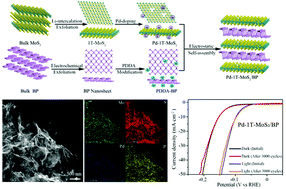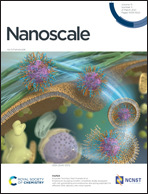A palladium doped 1T-phase molybdenum disulfide–black phosphorene two-dimensional van der Waals heterostructure for visible-light enhanced electrocatalytic hydrogen evolution†
Abstract
The electrocatalytic hydrogen evolution reaction (HER) is a green chemistry route for sustainable energy production. Compared to 2H-phase molybdenum disulfide (MoS2), the 1T-phase MoS2 (1T-MoS2) has higher theoretical activity and faster charge transfer kinetics, but the HER performance of 1T-MoS2 is commonly hindered by limited active edge/defect as well as poor structural stability. Herein, we synthesize a well-defined 2D vdW heterostructure composed of Pd doped 1T-MoS2 and black phosphorus (BP) nanosheets via electrostatic self-assembly. The spontaneous Pd doping under mild reaction conditions could introduce catalytically active sulfur vacancies in MoS2 without triggering a wide range of 1T to 2H phase transformation. The hetero-interfacial charge transfer from BP to Pd-1T-MoS2 can effectively improve the intrinsic activity of Pd-1T-MoS2 with a relatively low S vacancy concentration and simultaneously stabilize the 1T-phase structure. Due to the wide-range light absorption of BP nanosheets and the high carrier mobilities of 2D materials, the HER activity of the obtained Pd-1T-MoS2/BP could be further enhanced under ≥420 nm visible light illumination.



 Please wait while we load your content...
Please wait while we load your content...